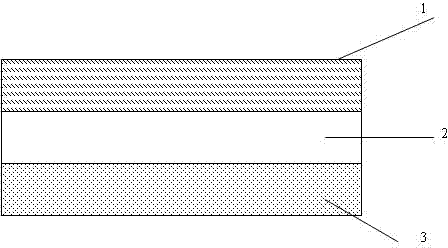A kind of encapsulation adhesive film for solar cell module
A technology for solar cells and encapsulation films, used in electrical components, circuits, adhesives, etc., can solve problems such as the decrease in the adhesion between EVA and glass interface, the hidden safety hazards of solar cell modules, and the inability to effectively solve the PID phenomenon. Inter-adhesion, improve service life, high adhesion effect
- Summary
- Abstract
- Description
- Claims
- Application Information
AI Technical Summary
Problems solved by technology
Method used
Image
Examples
Embodiment 1
[0040] 1 part by weight of silane grafted LDPE (SX522A: CM401 from AEI Compounds), 65 parts by weight of vinyl POE (EXACT5062 from ExxonMobil, melting peak at 43°C), and 35 parts by weight of ethylene-α-olefin Block copolymer (INFUSE9000 of DOW Chemical Company, melt flow rate measured at 190℃ 2.16kg is 0.5g / 10min) and 1.5 parts by weight of additives are fully mixed to form the material of the polyolefin bonding layer; Parts by weight of vinyl POE (TAFMER DF940 from Mitsui Chemicals, with a melting peak of 77°C), 40 parts by weight of ethylene-α-olefin block copolymer (Infuse 9530 from DOW Chemicals, measured at 190°C at 2.16 kg The melt flow rate is 5g / 10min) and 1.5 parts by weight of additives are fully mixed to form the material of the polyolefin barrier layer; according to the thickness of the polyolefin adhesive layer of 10μm and the thickness of the polyolefin barrier layer of 180μm, the two layers are mixed. Two extruders are used to co-extrude a flat die and cool and ...
Embodiment 2
[0042] 30 parts by weight of silane grafted MDPE (SX720: CM488 from AEI Compounds), 95 parts by weight of vinyl POE (ENGAGE8401 from DOW Chemicals, melting peak at 80°C), and 5 parts by weight of ethylene-α-olefin block Copolymer (INFUSE9530 of DOW Chemical Company, melt flow rate measured at 190℃2.16kg is 5g / 10min) and 1.5 parts by weight of additives are fully mixed to form the material of the polyolefin bonding layer; 90 parts by weight Vinyl POE (EXACT5062 of ExxonMobil, melting peak at 43°C), 10 parts by weight of ethylene-α-olefin block copolymer (INFUSE9000 of DOW Chemical Company, melt flow measured at 190°C 2.16kg The speed is 0.5g / 10min) and 1.5 parts by weight of the additives are fully mixed to form the material of the polyolefin barrier layer; according to the thickness of the polyolefin adhesive layer of 50μm and the thickness of the polyolefin barrier layer of 400μm, use two materials after mixing the two layers. A flat die was co-extruded by an extruder and cool...
Embodiment 3
[0044] 5 parts by weight of silane grafted LLDPE (LINKLON XLE815N from Mitsubishi Chemical Corporation), 75 parts by weight of vinyl POE (DF710 from Mitsui Chemicals, melting peak at 59°C), 25 parts by weight of ethylene-α-olefin block copolymer (Infuse 9100 of DOW Chemical Company, the melt flow rate measured at 190℃ 2.16kg is 1g / 10min) and 1.5 parts by weight of additives are thoroughly mixed to form the material of the polyolefin bonding layer; 60 parts by weight of ethylene Base POE (EXACT5062 of ExxonMobil, melting peak at 43°C), 40 parts by weight of ethylene-α-olefin block copolymer (INFUSE9000 of DOW Chemical Company, melt flow rate measured at 190°C 2.16kg 0.5g / 10min) and 1.5 parts by weight of additives are fully mixed to form the material of the polyolefin barrier layer; according to the thickness of the polyolefin adhesive layer of 10μm and the thickness of the polyolefin barrier layer of 400μm, use two sets of materials after the two layers are mixed The extruder c...
PUM
| Property | Measurement | Unit |
|---|---|---|
| melt flow index | aaaaa | aaaaa |
| thickness | aaaaa | aaaaa |
| thickness | aaaaa | aaaaa |
Abstract
Description
Claims
Application Information
 Login to View More
Login to View More - R&D
- Intellectual Property
- Life Sciences
- Materials
- Tech Scout
- Unparalleled Data Quality
- Higher Quality Content
- 60% Fewer Hallucinations
Browse by: Latest US Patents, China's latest patents, Technical Efficacy Thesaurus, Application Domain, Technology Topic, Popular Technical Reports.
© 2025 PatSnap. All rights reserved.Legal|Privacy policy|Modern Slavery Act Transparency Statement|Sitemap|About US| Contact US: help@patsnap.com

